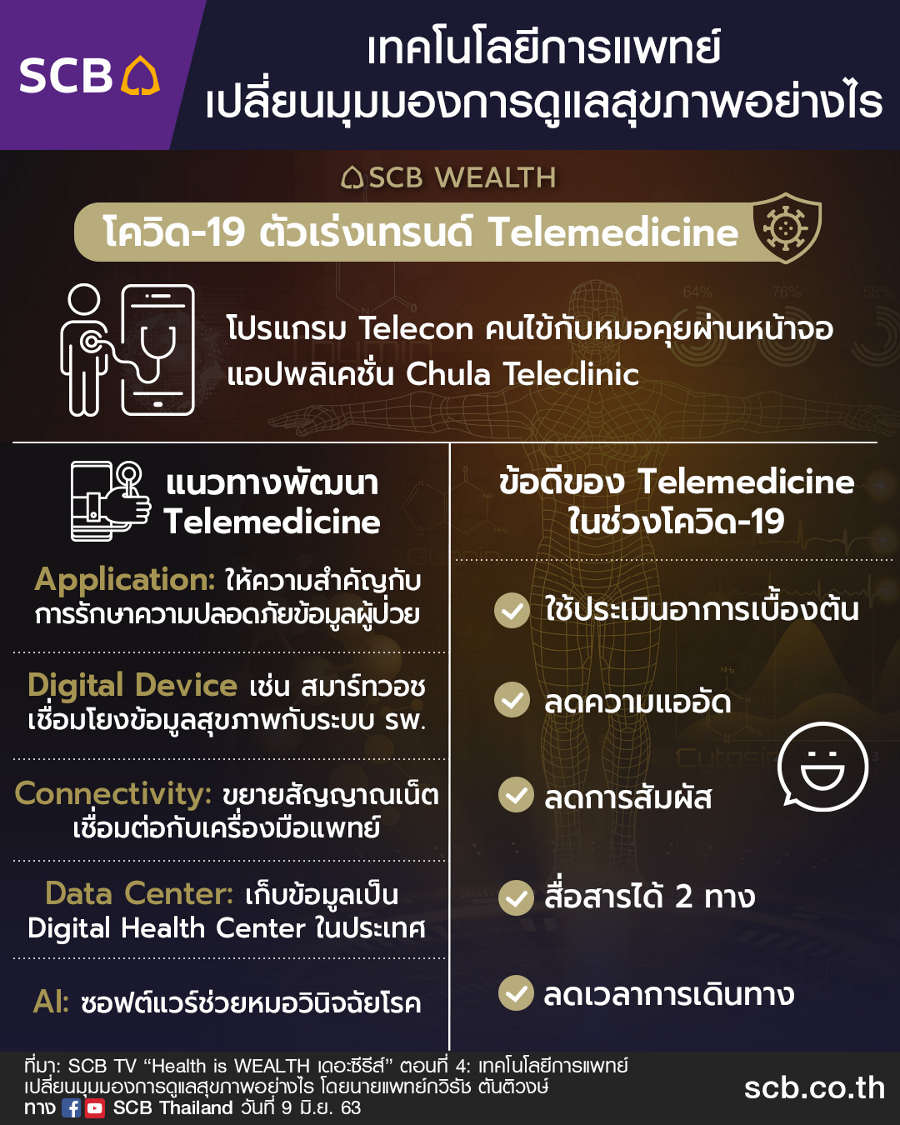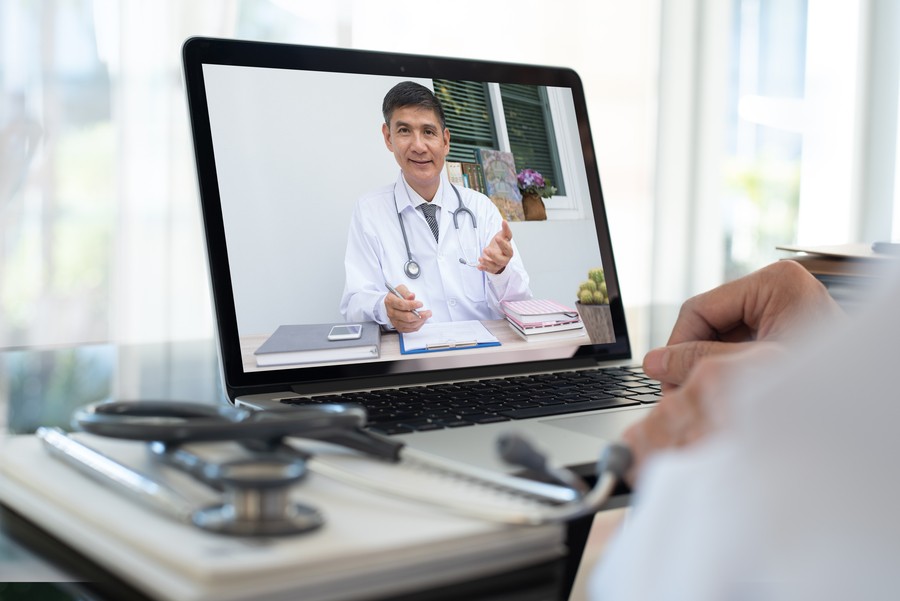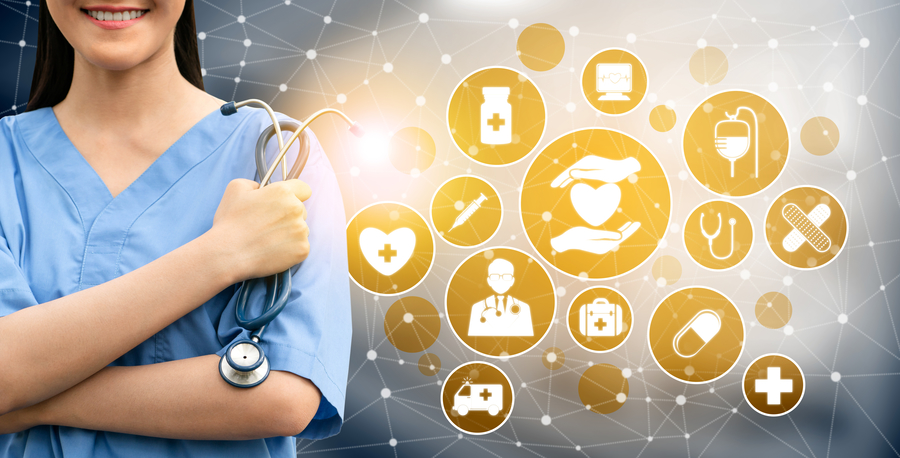I WANT
RELATED LINKS
I WANT
RELATED LINKS
RELATES LINKS
I WANT
RELATES LINKS
Services
Related Links
Use and Management of Cookies
We use cookies and other similar technologies on our website to enhance your browsing experience. For more information, please visit our Cookies Notice.
- Personal Banking
- Stories & Tips
- Protect My Family
- Telemedicine, a medical trend that is happening today
- Personal Banking
- ...
- Telemedicine, a medical trend that is happening today
Telemedicine, a medical trend that is happening today
17-06-2020
The digital age of communication created Big Data to change people's experiences in every part of society. Including visiting a doctor when sick, the next picture, at a public hospital crowded with many patients waiting to see a doctor, maybe reduced by using Telemedicine. Came to change the experience of seeing a doctor. Dr. Kawirat Tantiwong, Deputy Director of King Chulalongkorn Memorial Hospital Information Technology Department Gave the knowledge of the development of Telemedicine technology that changed people's health care perspective. Join by Mr. Sukit Udomsirikul, Managing Director of Research, Siam Commercial Securities Company Limited (SCBS).

How did the recent medical technology overview and Covid-19 make a difference?
Dr. Kawirat said that in past Thailand has constantly developed medical technology. Such as laparoscopic surgery Surgical tube insertion Radiotherapy has been around for over 20 years and robotic surgery has been there for at least 10 years. Therefore, it can be said that Thai medical is more ready than neighboring countries in this region. And when the Covid-19 virus crisis occurs. The epidemic situation that requires social distancing has become a catalyst for all sectors to adopt the technology. Whether it is society, business, communication, including medical issues that apply the concept of Telemedicine that used to communicate long-distance such as cross-country surgery. There is a specialist doctor who provides consultation during surgery in another country. Used in patient care with both the doctor and the patient being in the same place

During the March outbreak of Covid-19 at Chulalongkorn Hospital must find a way to take care of 300-400 patients a day and prevent the spread of infection in the hospital. By allowing patients to see a doctor on screen using the Telecon system that has strict data security measures. And from this point, it has developed into a Chat Based on the Line Chat system named Chula Covid-19 and later developed as an App-Based System named Chula Teleclinic and Chula Care. Which can be downloaded from the App Store / Play Store. In addition, in terms of dispensing in the case of patients receiving medication only will give additional medication for one week to extend the time for patients to receive medication at the hospital. Or dispense by mail by choosing a reliable carrier that has a working system, can specify the recipient and can check the delivery information details.

Advantages of Telemedicine
Dr. Kawirat said the advantages of Telemedicine technology are suitable for older patients, follow up groups, and refill drugs. The patients that the symptoms are not severe and have a history of treatment are able to use Telemedicine. Because it is 2-way communication which helps to increase convenience from reducing time, traveling, and reducing the risk of exposure and can reduce congestion in the hospital. Dr. Kawirat sees that the use of Telemedicine technology has changed the culture of visiting doctors in Thailand. Within 1 year, Chula Hospital targets people to switch to Telemedicine apps to reduce the number of people coming to the hospital by 20% from 5,000 people to 1,000 people. However, it does not mean that patients are ill cannot come to the hospital but use Telemedicine for screening for preliminary diagnosis. Which if seriously ill, can come to the hospital straight away.
The important thing that Telemedicine technology must keep is to keep the patient's private information confidential. In accordance with the law, the personal data protection act (PDPA). As for the Chula Hospital Prepared both the personnel Designing an application's journey step Security system the storage tank is at Chula Hospital and the backup cloud is in the country. With the objective of providing maximum care for patients' information

Telemedicine Development Guidelines
Dr. Kawirat sees that the next step towards Telemedicine development, in addition to the application. What is interesting is the development of digital devices such as smartwatches that can store health information such as heartbeat, etc. in real-time. And how to make this information linked to the information in the hospital system before patients come to see a doctor. And including the issue of internet connection (Connectivity) Internet Bandwidth That will help connect medical devices and data links more smoothly. The important thing is to develop the software or AI to become a medical assistant in managing Digital Health Data. Both data input and analysis output and diagnostic results. Dr. Kawirat views that there is still room for improvement. And unforgettable is the enormous amount of patient storage space that should be a Private Cloud in the country.

Join hands with partners to solve Pain Point
When talking about the pain point of medical technology development in Thailand Is a lack of confidence in their own research results. Causing to not be able to create products and investors do not dare to invest. For example, the vaccine research for the Covid-19 virus In Thailand, there has been some research. Which if will be produced for real use, must have factories to produce Thai people and the world for which must have Trust Thailand.
In the medical community, Chula Hospital Being a partner with Mahidol University. Both the Faculty of Medicine Siriraj Hospital and Faculty of Medicine, Ramathibodi Hospital, and including various faculties In Chulalongkorn University. Such as the Faculty of Engineering Institutions for innovation, integration, etc., as well as business sectors that come to support development in this area. This leads to the strength resulting from the cooperation of the Thai people.
In conclusion, Telemedicine technology is not a separate system. But to assess screening for initial illnesses before being admitted to the hospital. And use smartphones to benefit health care
